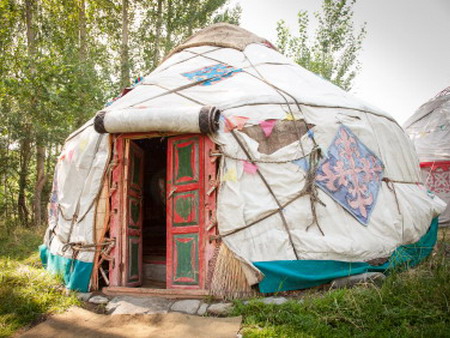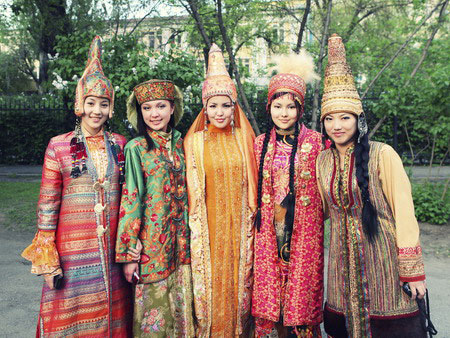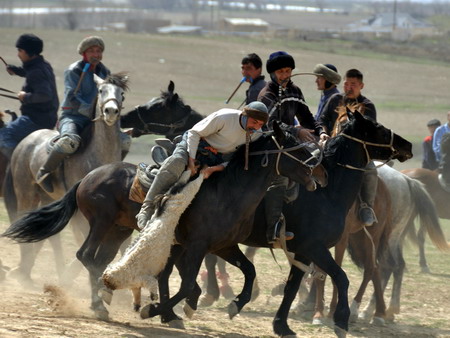Kazakhstan culture
The Kazakhs are an extremely hospitable people. If you come to a Kazakh home unexpected you will be received as if you had been invited. Since early childhood principles of respect of guests and older people as well as peacefulness and tolerance are instilled in every Kazakh and these are the national features of Kazakh culture and tradition. This is why Kazakhstan didn't have any significant national or religious conflicts in its history. Traditionally every guest is offered dishes of national Kazakh cuisine at the dastarkhan (the low table) in a yurt.
Yurts

Kazakh yurt
The yurt is one of the most sensible movable house. It is a comfortable and practical home, ideally suited to the local conditions and way of life – one of the greatest inventions of Eurasian nomads.
It is easily taken apart (it is said that a Kazakh woman can do it in half an hour) and carried on horses and camels. The yurt consists of three main elements: an extensible trellis base (the kerege), a dome made of poles (the uyk) and a round top (the shanyrak).
In ancient times Turks were reputed as the most skillful felt-makers of portable dwellings. Nowadays the Kazakhs use felt to cover the yurt and for its internal decoration, as well as to make carpets, dresses and shoes. The Kazakhs live in surrounded with ornaments. Each yurt is decorated with beautiful handmade wall carpets and multi-colored embroideries.
Handicrafts
Handicrafts – harnesses, felt mats (tekemets), articles made of wood, bone and metal – are lavishly decorated. Headdresses, dresses, bags and saddle-cloths are beautifully embroidered. They use traditional designs and carvings to make and decorate the wooden cups, large bowls and ladles used to serve for kumis (fermented mare's milk).
The horns of mountain rams and goats are used to decorate beds and caskets. Leather is used to make quivers, belts, harnesses and flasks (torsyks) for water and kumis Kazakh artisans are also very skillful jewelers.
Steppe zergers (jewelers.) favor white silver. Traditional Kazakh bell-shaped earrings, original bracelets (blezics), or the traditional bracelet linked to three rings by fine chains will certainly attract you.
The Kazakh national dress

The Kazakh national dress
The Kazakh national dress varies by regions. Men wear chapans, a kind of dressing gown with a belt, made of velvet and richly embroidered. They cover their heads with a soft skullcap (tobetai), a tall felt cap (kalpak) or a fox-fur hat with earflaps (malakai).
The women's national costume consists of a white cotton or colored silk dress, a velvet waistcoat with embroidery and a cap or a silk scarf. Elderly women wear a hood made of white cloth with a hole for the face (the kimeshek). Brides wear a tall pointed, richly decorated hat, topped with feathers (saukele).
Music and musical instruments
The Kazakhs love the art of words and their akyns (poets), who improvise at public competitions (aitys) accompanied by national stringed musical instruments: the dombra or the kobyz.
National games

Kokpar
National games: these are usually performed on horse-back and are an opportunity to witness the Kazakh's outstanding riding skills. Kazaksha kures (Kazakh wrestling), baiga (horse racing over 25, 50 or 100 km), kokpar (a sort of polo game played with a dead goat), kyz-kuu (catch the girl) and alty bakan (six-pole swing).
Nauryz
Nauryz (the Islamic New Year) is one of the biggest holidays in Central Asia. It is celebrated on the day of spring equinox of March 22. On that day, the streets of villages and towns are transformed. Guests are met in beautiful yurts with the traditional Nauryz kozhe dish made of seven traditional ingredients. People respecting this nearly month-long holiday forgive each other debts and offences.
Traditional Dishes of Kazakh Cuisine

Lamb cooking
Kazakh national cuisine reflects essence of the nation, its history, culture and traditions. Hospitality has always been a distinctive feature of the Kazakh nation, thus guests are always given a warm reception and the best seat. First he is offered kumys (horse milk), dairy drinks such as shubat (made of camel milk) or ayran (made of cow milk).
Then baursaks are served to the tea with milk and cream, these are fried puffy bread/bun, with raisins, iriimshik (local quark product) and kurt (pressed sour cream, dried in different shapes).
Then dastarhan (tablecloth) is filled with local bread and refreshments of horse meat and lamb: kazi, sujak, jal, jaya, karta and kabyrga.
The most popular Kazakh dish is 'besbarmak'. It is the main dish of the national cuisine and is translated as 'five fingers', and because the dish is eaten with hands.
Classic recipe of Besbarmak is usually boiling a broth with several types of meat (horse meat, lamb, beef and camel meat) and rectangle-shaped pasta.
Carving the meat at the table is a whole ritual which has a deep meaning. There is a distinct subordination on who gets which piece of meat from the host – pelvic bones and shanks are offered to elderly honored guests, breast part is given to the son or a bride, neck bones - to single females and so on.
To carve and distribute the meat of the sheep's head cooked in a special way is trusted to a high-ranked guest. According to local traditions, meat is passed from the elderly to the children and then to close and far relatives.
Traditional first course dish in the Kazakh cuisine is shurpa, a well cooked broth with meat, vegetables and spices. It is usually served in big bowls. During and after the meal kumys and tea are served.
Traditionally Kazakh cuisine was based on meat and dairy products. Later the list was enriched with vegetables, fruits, fish, seafood, farinaceous dishes and sweets.
Today different representatives living in Kazakhstan are gathered around the dastarhan: Russians, Tatars, Ukrainians, Uzbeks, Uygurs, Dungans, Germans and Koreans. These nations have lived in peace on this land for a long time and certainly influenced on lifestyle, culture and the cuisine of Kazakh people. Thus, the modern Kazakh cookery includes dishes of Uzbek, Uygur, Russian, Tatar and Korean cuisines.

 Province Events
Province Events Major Events
Major Events Highlights
Highlights
